SpHMA3: A Genetic Boost for Cadmium Tolerance and Bioremediation in Arabidopsis thaliana and Zea mays
Abstract
1. Introduction
2. Results
2.1. Phylogenetic Tree and Conserved Structural Domain Analysis of HMA Family Genes in Several Major Crops
2.2. Identification of Arabidopsis thaliana athma3 Pure Mutants and Gene Transcription Levels
2.3. Mutant of AtHMA3 Decreased Resistance to Cd Stress in Arabidopsis
2.4. Decreased Cd Accumulation in the Arabidopsis thaliana athma3 Mutant
2.5. Overexpression of ZmHMA3 Increases Tolerance to Heavy Metal Stress in Arabidopsis thaliana
2.6. Overexpression of SpHMA3 Improves Tolerance to Heavy Metal Stress in Maize
2.7. Functional Expression of SpHMA3 Under Cd Stress
2.8. Overexpression of the SpHMA3 Gene Enhances the Accumulation Enrichment Capacity of Plants to Heavy Metal Stresses
2.9. Physiological Response of SpHMA3 Transgenic Maize and Arabidopsis Under Cd Stress
2.10. Remediation of Cd-Contaminated Soil by Overexpressing SpHMA3 Maize
2.11. Characterization of Cd Enrichment Transfer in SpHMA3 Overexpression Material
3. Discussion
4. Materials and Methods
4.1. Plant Materials and Growing Conditions
4.2. SpHMA3 and AtHMA3 Expression Analysis
4.3. Subcellular Localization Assay
4.4. Genetic Transformation of Arabidopsis thaliana
4.5. Validation of SpHMA3 Gene Overexpression in Arabidopsis thaliana
4.6. Arabidopsis Germination Phenotype Under Cd Stress
4.7. Determination of Cd Content in Arabidopsis thaliana
4.8. Measurement of Physiological and Biochemical Indexes in Arabidopsis and Maize Seedlings
4.9. Overexpression of SpHMA3 Gene in Maize
4.10. Determination of Cd Content in Various Parts of Maize
4.11. Statistical Analysis
5. Conclusions
6. Glossary
- Heavy Metal ATPase (HMA): the HMA heavy metal transporter protein is a transmembrane transporter protein belonging to the P-type ATPase family, which mainly provides energy for metal transport by hydrolyzing ATP. This protein generally contains 6–8 transmembrane fragments and can selectively transport heavy metal cations, which plays an important role in phytoremediation of heavy metal contaminated soil.
- Coding sequence (CDS): refers to a sequence that encodes a segment of a protein product. CDS is a structural genomics term that denotes the portion of a DNA sequence that is capable of being transcribed into mRNA and further translated into a protein.
- Complementary DNA(cDNA): complementary (sometimes called copy) DNA, specifically a strand of DNA that is complementary to RNA after reverse transcription in vitro. Unlike what we normally call genomic DNA, cDNA does not have introns but only exon sequences.
- Quantitative Real-time PCR(qRT-PCR): it is a method to measure the total amount of product after each polymerase chain reaction (PCR) cycle with fluorescent chemicals in a DNA amplification reaction. It is a method for quantitatively analyzing specific DNA sequences in the sample to be tested by internal or external reference methods.
- Superoxide Dismutase(SOD): superoxide dismutase is also known as superoxide dismutase. It is a class of enzymes that catalyze the disproportionation of superoxide anion radicals (O2−) to H2O2 and O2. This enzyme is extremely widely distributed and has so far been isolated from a variety of organisms including bacteria, fungi, algae, plants, protozoa, insects, fish and mammals.
- Peroxidase(POD): peroxidases are the hallmark enzymes of the peroxisome, its class of oxidoreductases, and they catalyze many reactions. Peroxidases are enzymes that catalyze the oxidation of substrates using hydrogen peroxide as an electron acceptor.
- Catalase(CAT): it is an enzyme that catalyzes the breakdown of hydrogen peroxide into oxygen and water and is found in the peroxisomes of cells.
- Malondialdehyde(MDA): it is an organic compound with the molecular formula C3H4O2, which belongs to the list of group 3 carcinogens.
- Bioconcentration Factor (BCF): BCF is the ratio of the concentration of a compound in biological tissue (dry weight) to the concentration dissolved in water, or it can be considered as the ratio of the rate of uptake of the compound by the organism to the rate of purification of the compound from the organism, and it is used to indicate the magnitude of bioconcentration of organic compounds in the organism. The bioconcentration coefficient is an important indicator to describe the accumulation trend of chemical substances in organisms.
- Plant Transport Coefficient(BTF): it is the ratio of the metal content in the above-ground part of the plant to the metal content in the below-ground part of the plant, and is used as an indicator to evaluate the ability of the plant to transport and enrich heavy metals from the below-ground part of the plant to the above-ground part of the plant.
- Wild Type(WT): it is an individual or gene that has not been artificially mutated in nature. In genetics, a wild type is a phenotype that is present in more than 1% of a population and is often used as a standard control gene.
- Thousand-grain Weight(TKW): it is the weight of 1000 grains of rice in grams. It is an indicator of the size and fullness of the seed, which is used to test the quality of the seed and the content of the crop test, and it is also an important basis for predicting yield in the field.
Supplementary Materials
Author Contributions
Funding
Institutional Review Board Statement
Informed Consent Statement
Data Availability Statement
Conflicts of Interest
References
- Zhuang, P.; McBride, M.B.; Xia, H.; Li, N.; Li, Z. Health risk from heavy metals via consumption of food crops in the vicinity of Dabaoshan mine, South China. Sci. Total Environ. 2009, 407, 1551–1561. [Google Scholar]
- Zhang, X.; Chen, D.; Zhong, T.; Zhang, X.; Cheng, M.; Li, X. Assessment of cadmium (Cd) concentration in arable soil in China. Environ. Sci. Pollut. Res. 2015, 22, 4932–4941. [Google Scholar]
- Zhou, C. Research progress of in situ remediation technology for cadmium contaminated soil. Nonferrous Metall. Des. Res. 2018, 39, 24–28+32, (In Chinese with English Abstract). [Google Scholar]
- Ramakrishnan, S.; Sulochana, K.N.; Selvaraj, T.; Rahim, A.A.; Lakshmi, M.; Arunagiri, K. Smoking of beedies and cataract: Cadmium and vitamin C in the lens and blood. Br. J. Ophthalmol. 1995, 79, 6–202. [Google Scholar] [CrossRef][Green Version]
- Chen, Z.; Mo, D.; Chou, R. Hazards of Cadmium Pollution on Biological Organisms and Countermeasures for Prevention and Control. Environ. Prot. Sci. 2001, 37–39, (In Chinese with English Abstract). [Google Scholar]
- Godt, J.; Scheidig, F.; Grosse-Siestrup, C.; Esche, V.; Brandenburg, P.; Reich, A.; Groneberg, D.A. The toxicity of cadmium and resulting hazards for human health. J. Occup. Med. Toxicol. 2006, 1, 22. [Google Scholar] [CrossRef]
- Xie, H.; Chen, A.; Zhang, F.; Xiong, Y.; Chen, Y.L.; Liu, J.; Zhou, L.Y.; Lin, R.Y. Physiological response of Perilla frutescens to different concentrations of cadmium stress. Chin. J. Ecol. Agric. 2011, 19, 672–675, (In Chinese with English Abstract). [Google Scholar]
- Li, J.; Shi, G.; Wei, Y. Heavy metal cadmium to each other on the grass growth and physiological characteristics influence. J. Anhui Agric. Sci. 2011, 33, 2174–2176+2182, (In Chinese with English Abstract). [Google Scholar] [CrossRef]
- Dragomir, V.; Ioan Sebastian, B.; Alina, B.; Victor, P.; Tanasă, L.; Horhocea, D. An overview of global maize market compared to Romanian production. Rom. Agric. Res. 2022, 39, 535–544. [Google Scholar]
- Adiaha, M.S.; Agba, O.A.; Attoe, E.E.; Ojikpong, T.O.; Kekong, M.A.; Obio, A.; Undie, U.L. Effect of maize (Zea mays L.) on human development and the future of man-maize survival: A review. World Sci. News 2016, 59, 52–62. [Google Scholar]
- Ghosh, P.K.; Das, A.; Saxena, R.; Banerjee, K.; Kar, G.; Vijay, D. (Eds.) Trajectory of 75 Years of Indian Agriculture After Independence; Springer: Singapore, 2023. [Google Scholar]
- Kaul, J.; Jain, K.; Olakh, D. An overview on role of yellow maize in food, feed and nutrition security. Int. J. Curr. Microbiol. Appl. Sci. 2019, 8, 3037–3048. [Google Scholar] [CrossRef]
- Sangwan, S.; Kumar, S.; Goyal, S. Maize utilisation in food bioprocessing: An overview. In Maize: Nutrition Dynamics and Novel Uses; Springer: New Delhi, India, 2014; pp. 119–134. [Google Scholar]
- Rascio, N.; Vecchia, F.D.; Ferretti, M.; Merlo, L.; Ghisi, R. Some effects of cadmium on maize plants. Arch. Environ. Contam. Toxicol. 1993, 25, 244–249. [Google Scholar] [CrossRef]
- Florijn, P.J.; Van Beusichem, M.L. Uptake and distribution of cadmium in maize inbred lines. Plant Soil 1993, 150, 25–32. [Google Scholar] [CrossRef]
- Anjum, S.A.; Tanveer, M.; Hussain, S.; Bao, M.; Wang, L.; Khan, I.; Ullah, E.; Tung, S.A.; Samad, R.A.; Shahzad, B. Cadmium toxicity in Maize (Zea mays L.): Consequences on antioxidative systems, reactive oxygen species and cadmium accumulation. Environ. Sci. Pollut. Res. 2015, 22, 17022–17030. [Google Scholar] [CrossRef] [PubMed]
- Pál, M.; Horváth, E.; Janda, T.; Páldi, E.; Szalai, G. Physiological changes and defense mechanisms induced by cadmium stress in maize. J. Plant Nutr. Soil Sci. 2006, 169, 239–246. [Google Scholar] [CrossRef]
- Axelsen, K.B.; Palmgren, M.G. Evolution of substrate specificities in the P-type ATPase superfamily. J. Mol. Evol. 1998, 46, 84–101. [Google Scholar] [CrossRef] [PubMed]
- Banci, L.; Bertini, I.; Ciofi-Baffoni, S.; Su, X.-C.; Miras, R.; Bal, N.; Mintz, E.; Catty, P.; Shokes, J.E.; Scott, R.A. Structural Basis for Metal Binding Specificity: The N-terminal Cadmium Binding Domain of the P1-type ATPase CadA. J. Mol. Biol. 2006, 356, 638–650. [Google Scholar] [CrossRef][Green Version]
- Toyoshima, C. How Ca2+-ATPase pumps ions across the sarcoplasmic reticulum membrane. Biochim. Biophys. Acta 2009, 1793, 941–946. [Google Scholar] [CrossRef]
- Smith, A.T.; Smith, K.P.; Rosenzweig, A.C. Diversity of the metal-transporting P1B-type ATPases. J. Biol. Inorg. Chem. 2014, 19, 947–960. [Google Scholar] [CrossRef]
- Axelsen, K.B.; Palmgren, M.G. Inventory of the superfamily of P-type ion pumps in Arabidopsis. Plant Physiol. 2001, 126, 696–706. [Google Scholar] [CrossRef]
- Kim, Y.; Choi, H.; Segami, S.; Cho, H.; Martinoia, E.; Maeshima, M.; Lee, Y. AtHMA1 contributes to the detoxification of excess Zn(II) in Arabidopsis. Plant J. Cell Mol. Biol. 2009, 58, 737–753. [Google Scholar]
- Morel, M.; Crouzet, J.; Gravot, A.; Auroy, P.; Leonhardt, N.; Vavasseur, A.; Richaud, P. AtHMA3, a P1B-ATPase allowing Cd/Zn/co/Pb vacuolar storage in Arabidopsis. Plant Physiol. 2009, 149, 894–904. [Google Scholar] [PubMed]
- Morin, I.; Gudin, S.; Mintz, E.; Cuillel, M. Dissecting the role of the N-terminal metal-binding domains in activating the yeast copper ATPase in vivo. FEBS J. 2009, 276, 4483–4495. [Google Scholar] [PubMed]
- Lu, S.; Du, Y.; Zhong, D.; Zhao, B.; Li, X.; Xu, M.; Li, Z.; Luo, Y.; Yan, J.; Wu, L. Comparison of Trace Element Emissions from Thermal Treatments of Heavy Metal Hyperaccumulators. Environ. Sci. Technol. 2012, 46, 5025. [Google Scholar]
- Zhong, D.; Zhong, Z.; Wu, L.; Ding, K.; Luo, Y.; Christie, P. Pyrolysis of Sedum plumbizincicola, a zinc and cadmium hyperaccumulator: Pyrolysis kinetics, heavy metal behaviour and bio-oil production. Clean Technol. Environ. Policy 2016, 18, 2315–2323. [Google Scholar]
- Cao, D.; Zhang, H.; Wang, Y.; Zheng, L. Accumulation and Distribution Characteristics of Zinc and Cadmium in the Hyperaccumulator Plant Sedum plumbizincicola. Bull. Environ. Contam. Toxicol. 2014, 93, 171–176. [Google Scholar]
- Wu, L.H.; Liu, Y.J.; Zhou, S.B.; Guo, F.G.; Bi, D.; Guo, X.H.; Baker, A.J.M.; Smith, J.A.C.; Luo, Y.M. Sedum plumbizincicola XH Guo et SB Zhou ex LH Wu (Crassulaceae): A new species from Zhejiang Province, China. Plant Syst. Evol. 2013, 299, 487–498. [Google Scholar]
- Wu, L.H.; Zhou, S.B.; Bi, D.; Guo, X.H.; Qin, W.H.; Wang, H.; Wang, G.J.; Luo, Y.M. Sedum plumbizincicola, a new species of the Crassulaceae from Zhejiang, China. Soils 2006, 38, 632–633. [Google Scholar]
- Luo, P.; Wu, J.; Li, T.T.; Shi, P.; Ma, Q.; Di, D.W. An Overview of the Mechanisms through Which Plants Regulate ROS Homeostasis under Cadmium Stress. Antioxidants 2024, 13, 1174. [Google Scholar] [CrossRef]
- Liu, H.; Zhao, H.; Wu, L.; Liu, A.; Zhao, F.; Xu, W. Heavy metal ATPase 3 (HMA3) confers cadmium hypertolerance on the cadmium/zinc hyperaccumulator Sedum plumbizincicola. New Phytol. 2017, 215, 687–698. [Google Scholar]
- Zhao, X.W. Analysis of the Genetic Basis for the Control of Heavy Metal Cadmium Cd Accumulation in Maize. Ph.D. Thesis, Sichuan Agricultural University, Ya’an, China, 2018. [Google Scholar]
- Sasaki, A.; Yamaji, N.; Ma, J.F. Overexpression of OsHMA3 enhances Cd tolerance and expression of Zn transporter genes in rice. J. Exp. Bot. 2014, 65, 6013–6021. [Google Scholar] [CrossRef] [PubMed]
- Hu, H.Z. Effects of High pH Stress on PCD in Primary Root Genesis of Arabidopsis Seedlings. Master’s Thesis, Shandong Agricultural University, Tai’an, China, 2007. [Google Scholar]
- Gill, S.S.; Tuteja, N. Reactive oxygen species and antioxidant machinery in abiotic stress tolerance in crop plants. Plant Physiol. Biochem. 2010, 48, 909–930. [Google Scholar] [CrossRef] [PubMed]
- Ma, G.; Yao, Y. Effect of zinc on the growth of maize under cadmium stress. J. Green Sci. Technol. 2013, 09, 166–167. (In Chinese) [Google Scholar]
- Chen, Y.; Chao, Z.F.; Jin, M.; Wang, Y.L.; Li, Y.; Wu, J.C.; Xiao, Y.; Peng, Y.; Lv, Q.Y.; Gui, S.; et al. A heavy metal transporter gene ZmHMA3a promises safe agricultural production on cadmium-polluted arable land. J. Genet. Genom. 2023, 50, 130–134. [Google Scholar] [CrossRef] [PubMed]
- Di, D.W.; Li, T.T.; Yu, Z.L.; Cheng, J.; Wang, M.; Liu, C.F.; Wang, Y.; Kronzucker, H.J.; Yu, M.; Shi, W. Ammonium mitigates cadmium toxicity by activating the bZIP20-APX2/CATA transcriptional module in rice seedlings in an ABA-dependent manner. J. Hazard. Mater. 2024, 480, 135874. [Google Scholar] [CrossRef]
- Zhang, T.; Zhou, J.; Zhao, W.; Li, X.; Wang, X.; Li, L.; Xin, Z.; Sun, X.; Jin, W. Research on the safe growth and planting of annual economic plants in cadmium-polluted farmland in red soil area. Jiangxi Sci. 2024, 4, 820–825, (In Chinese with English Abstract). [Google Scholar]
- Tan, C.; Yang, Y. Study on the bioremediation ability of lily on soil heavy metal pollution. Environ. Sci. Manag. 2024, 49, 154–157, (In Chinese with English Abstract). [Google Scholar]
- Shu, Y.; Liu, Y.; Liu, M.; Bi, J. Study on the Energy Potential of Collectable Straw and Bioethanol Production Potential of Major Crops in China. J. Beijing Inst. Technol. (Soc. Sci. Ed.) 2023, 25, 64–72, (In Chinese with English Abstract). [Google Scholar]
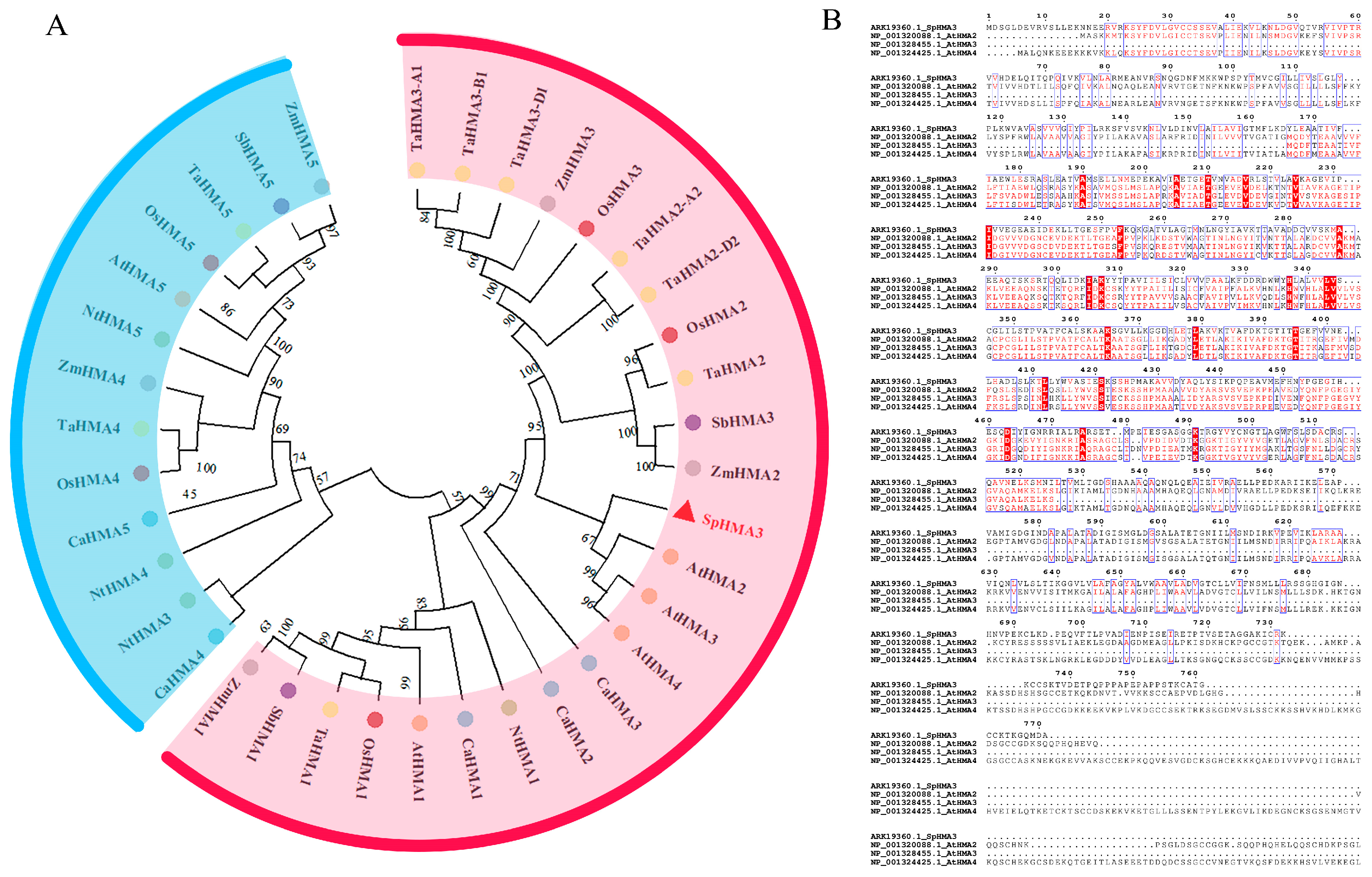

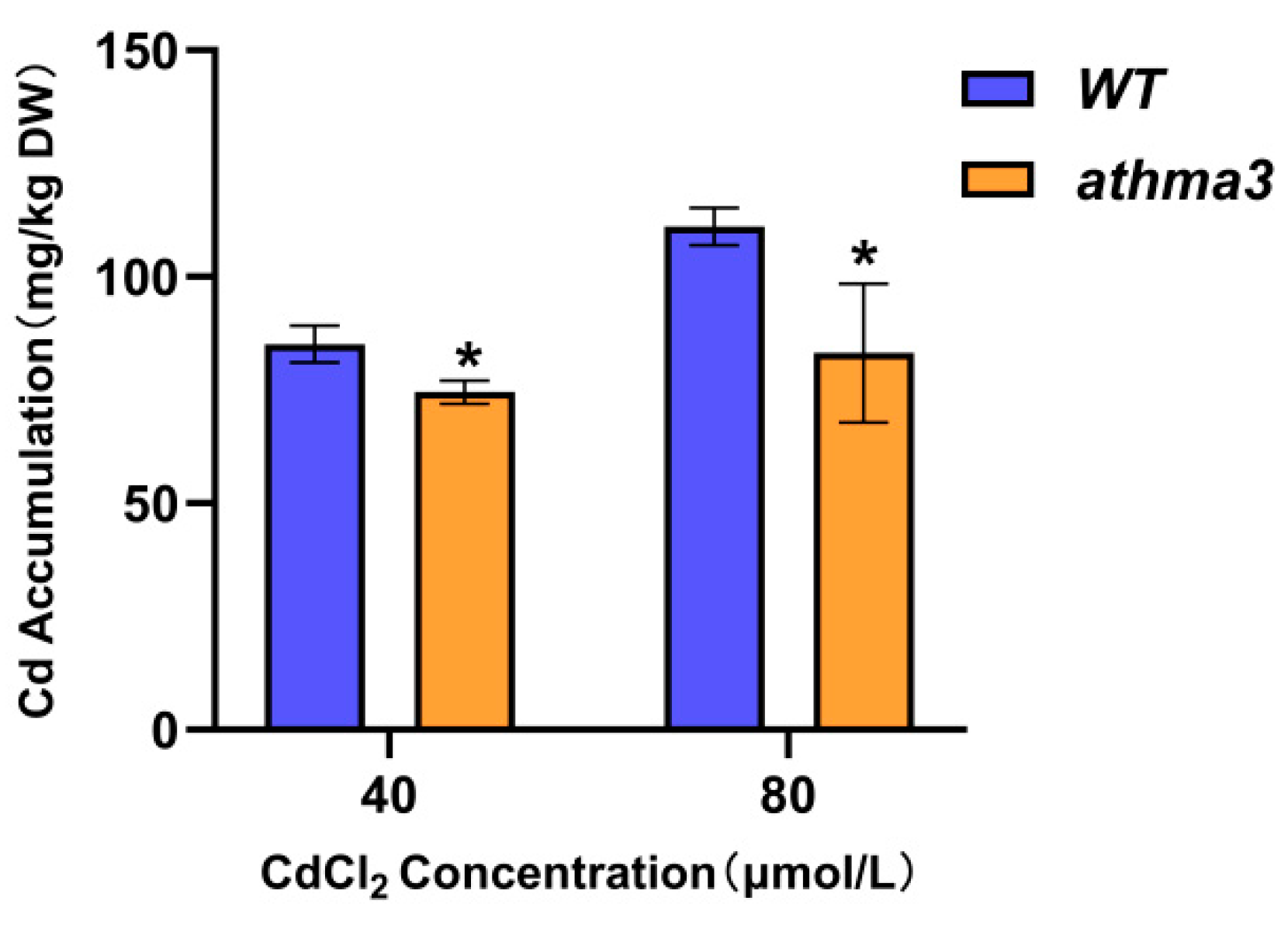
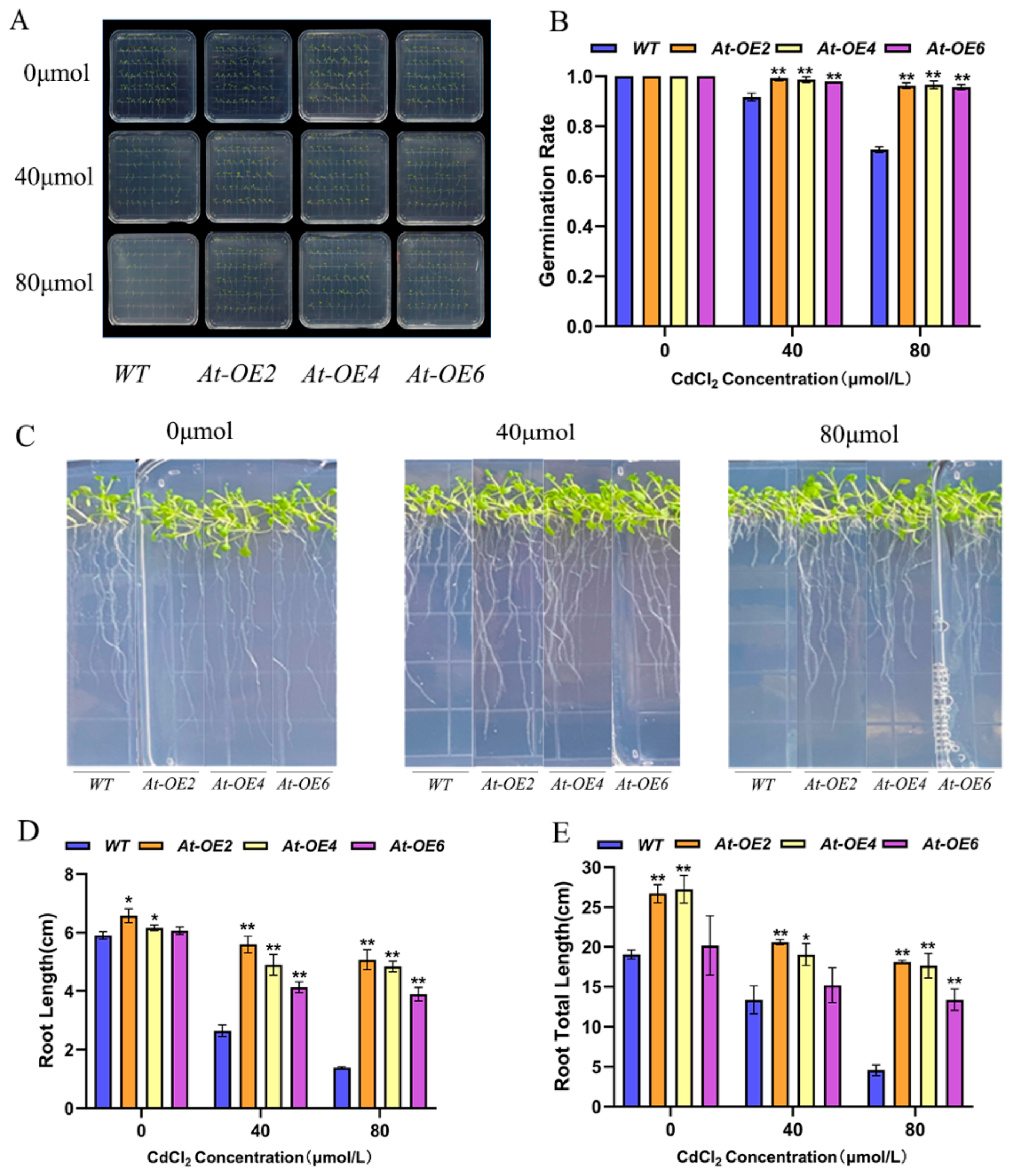
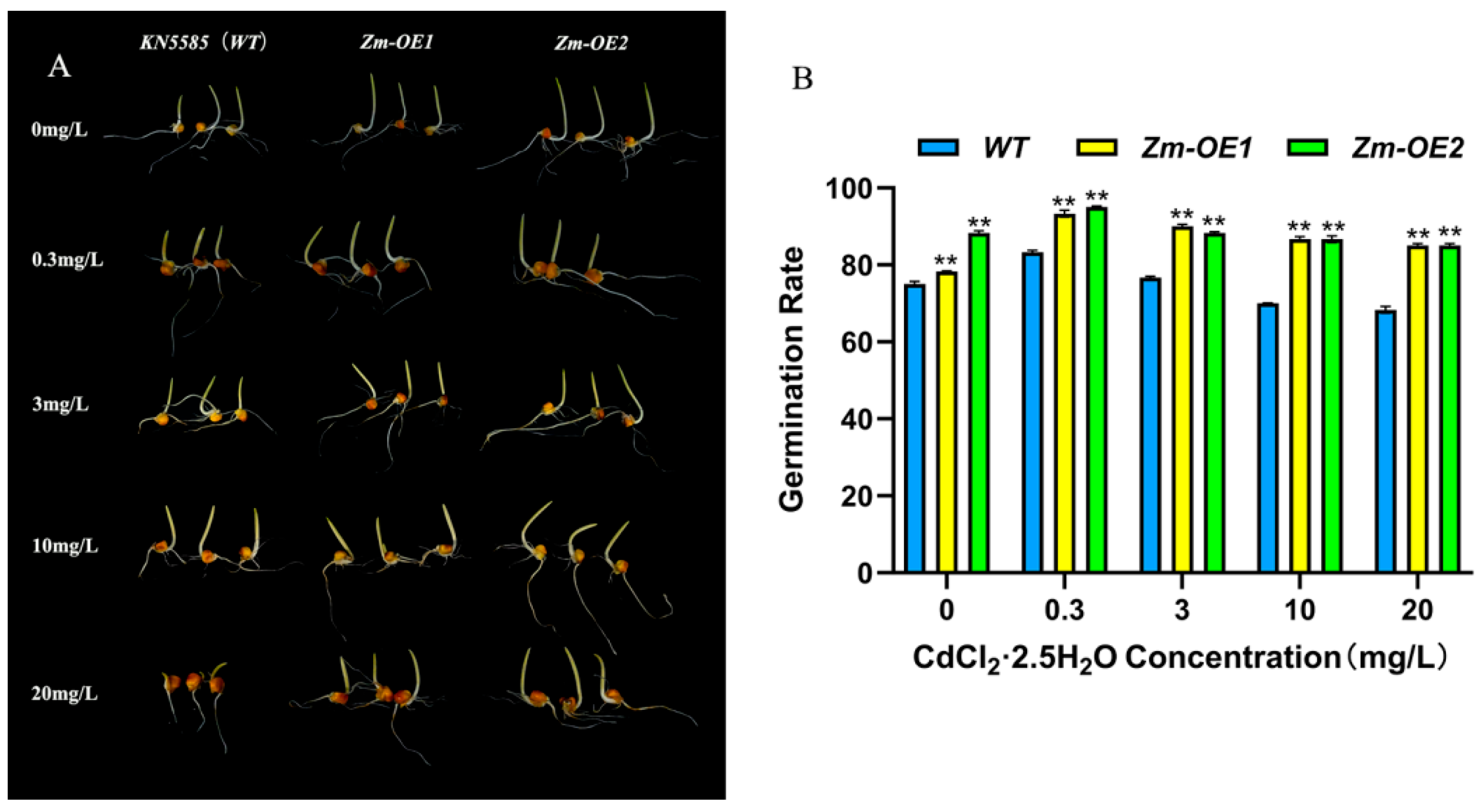
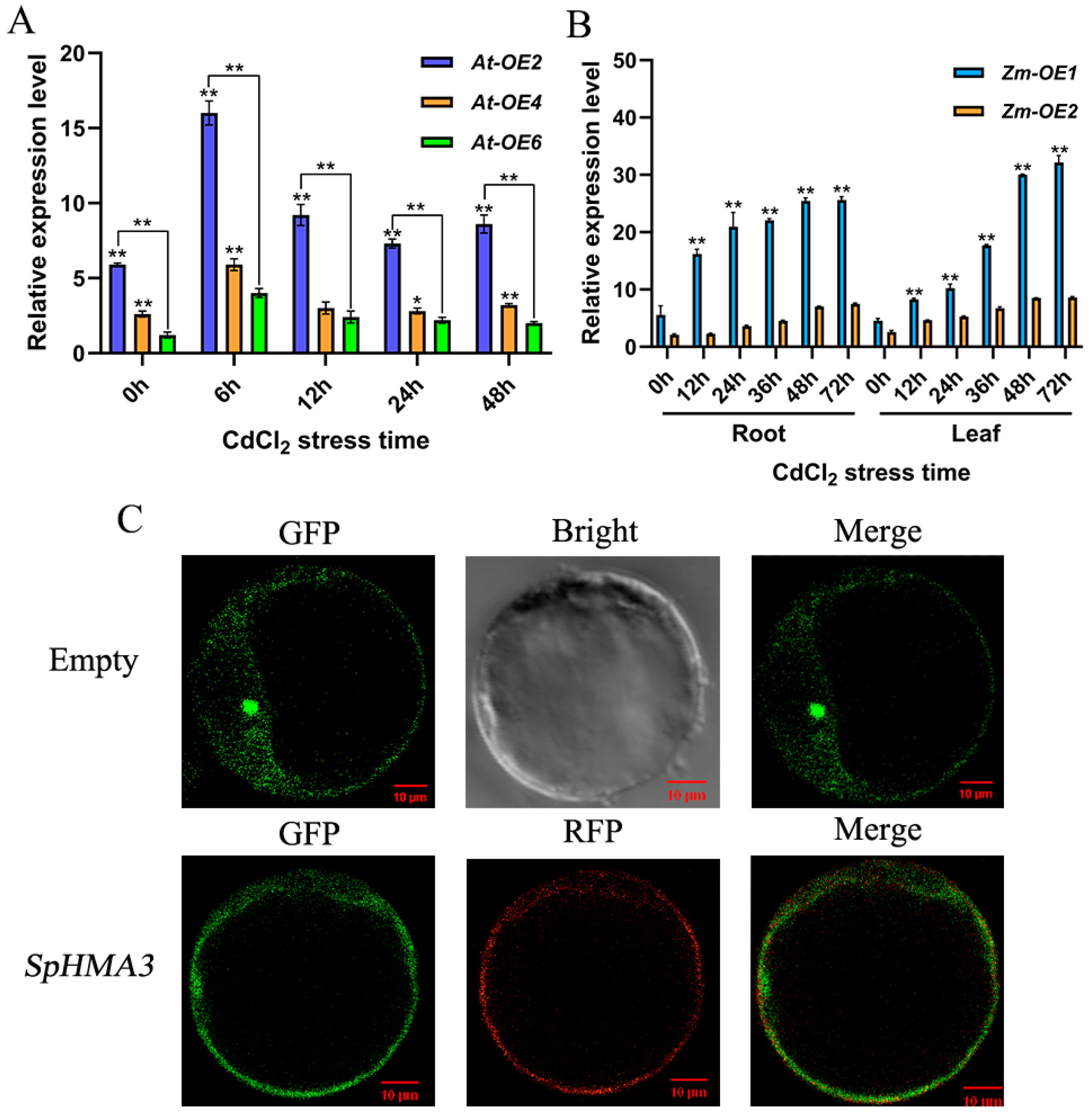
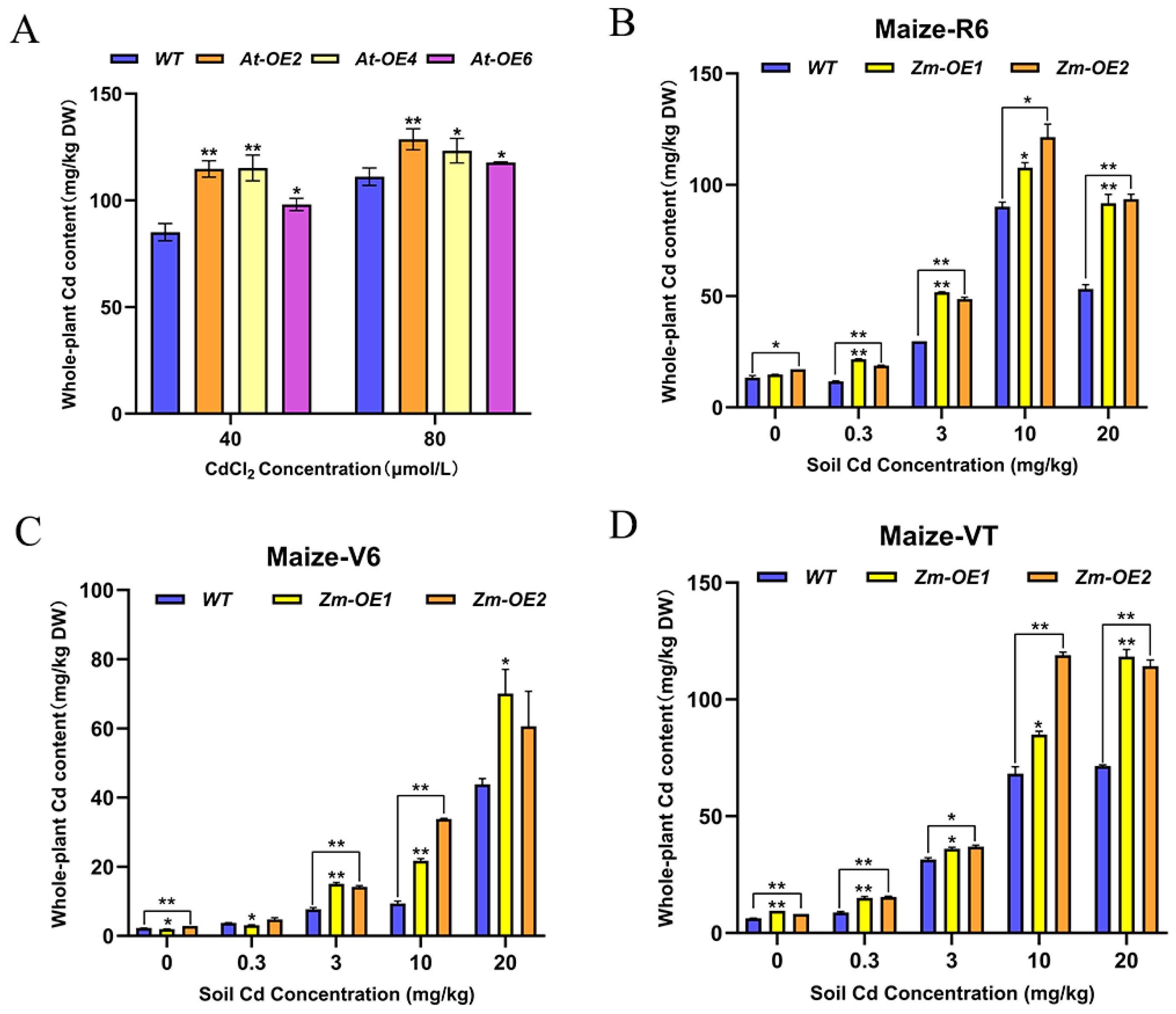
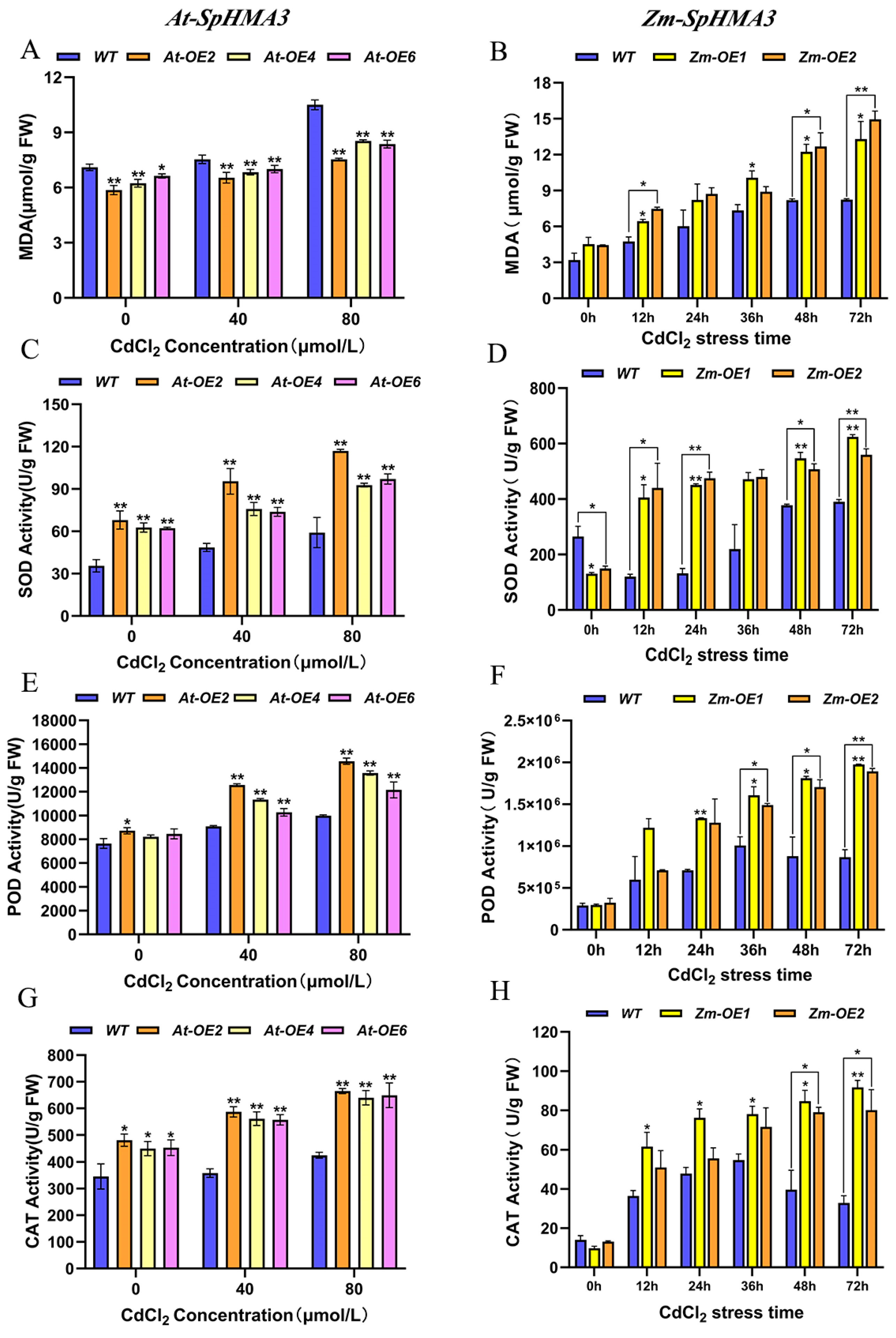
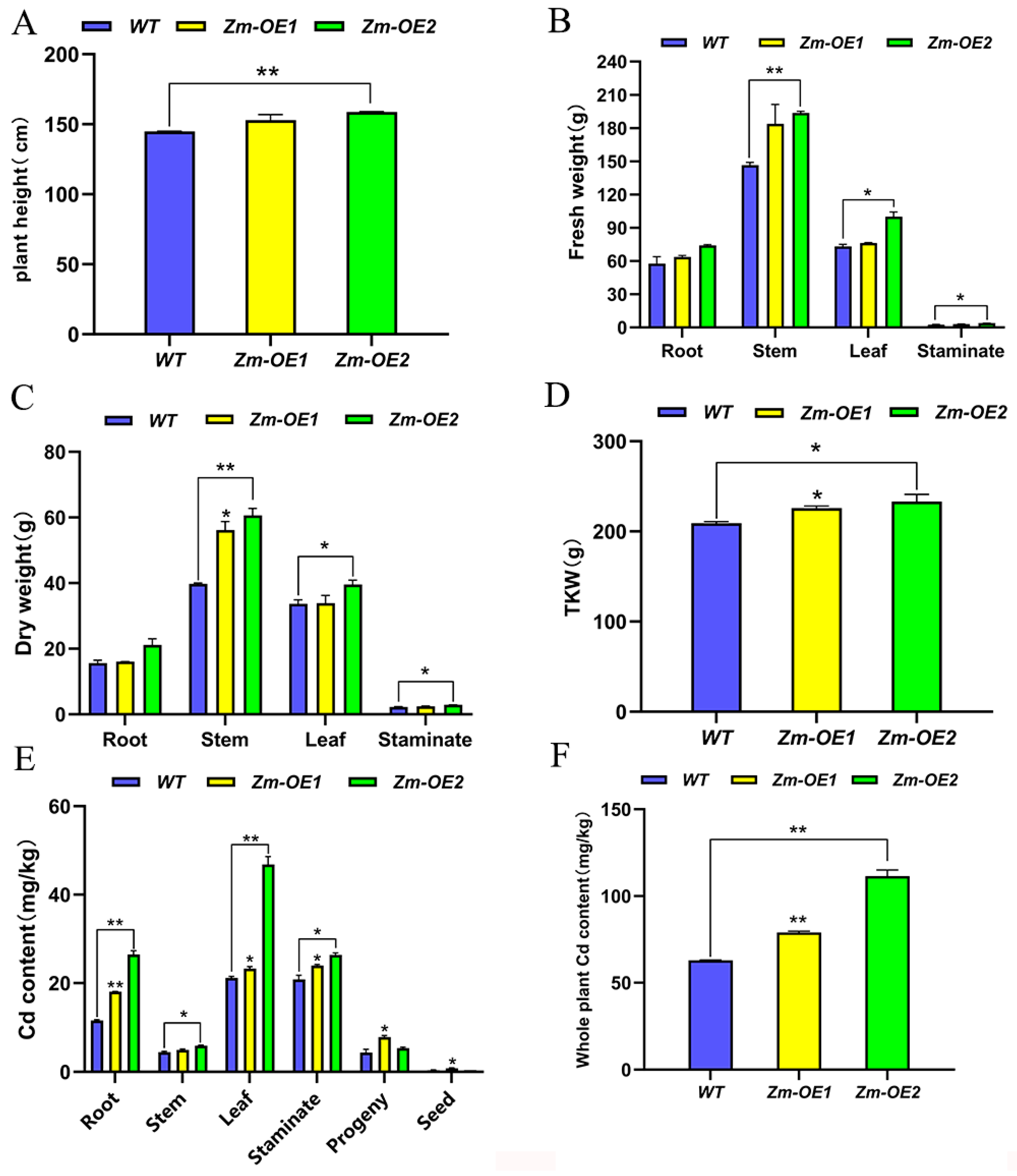

Disclaimer/Publisher’s Note: The statements, opinions and data contained in all publications are solely those of the individual author(s) and contributor(s) and not of MDPI and/or the editor(s). MDPI and/or the editor(s) disclaim responsibility for any injury to people or property resulting from any ideas, methods, instructions or products referred to in the content. |
© 2025 by the authors. Licensee MDPI, Basel, Switzerland. This article is an open access article distributed under the terms and conditions of the Creative Commons Attribution (CC BY) license (https://creativecommons.org/licenses/by/4.0/).
Share and Cite
Pu, R.; Hu, G.; Jiang, Q.; Zhou, W.; Zhao, B.; Xia, C.; Hu, J.; Xiang, W.; Liu, M.; Deng, H.; et al. SpHMA3: A Genetic Boost for Cadmium Tolerance and Bioremediation in Arabidopsis thaliana and Zea mays. Int. J. Mol. Sci. 2025, 26, 3487. https://doi.org/10.3390/ijms26083487
Pu R, Hu G, Jiang Q, Zhou W, Zhao B, Xia C, Hu J, Xiang W, Liu M, Deng H, et al. SpHMA3: A Genetic Boost for Cadmium Tolerance and Bioremediation in Arabidopsis thaliana and Zea mays. International Journal of Molecular Sciences. 2025; 26(8):3487. https://doi.org/10.3390/ijms26083487
Chicago/Turabian StylePu, Rumin, Gaojiao Hu, Qian Jiang, Wenhao Zhou, Binhan Zhao, Chao Xia, Jianfeng Hu, Wenqi Xiang, Mao Liu, Hanyu Deng, and et al. 2025. "SpHMA3: A Genetic Boost for Cadmium Tolerance and Bioremediation in Arabidopsis thaliana and Zea mays" International Journal of Molecular Sciences 26, no. 8: 3487. https://doi.org/10.3390/ijms26083487
APA StylePu, R., Hu, G., Jiang, Q., Zhou, W., Zhao, B., Xia, C., Hu, J., Xiang, W., Liu, M., Deng, H., Zhao, S., Han, J., Lv, G., & Lin, H. (2025). SpHMA3: A Genetic Boost for Cadmium Tolerance and Bioremediation in Arabidopsis thaliana and Zea mays. International Journal of Molecular Sciences, 26(8), 3487. https://doi.org/10.3390/ijms26083487





